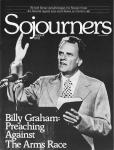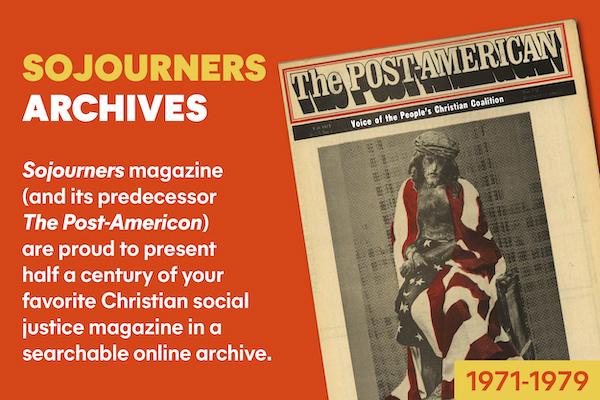"There were lots of fights and alcoholism back then. The police came to our street so much that we asked them, 'Why don't you just rent an apartment and stay?' I think God looked down on us and said, 'Hell is right there on Belmont Street.'"
For Rita Branham and the other residents of her block, there was little hope in the early 1970s. But, while they lived in the violence and deterioration of Washington, D.C.'s 14th Street "riot corridor," hope was brewing in a very different part of the city.
That place was the lunch room at the National Gallery of Art -- an unusual spot for a new ministry to Washington's poor to be born. There Tom Nees, pastor of the wealthy Washington First Church of the Nazarene, and John Lunsford, a criminal lawyer in the parish, held clandestine meetings.
They were fearful of the reaction that their denomination might have toward their vision of an alternative church. But they eventually "came out of the lunch room" and shared their thoughts with denomination leaders. They received overwhelming support.
Housing was the issue that Tom and John identified as most pressing. Speculation in many parts of the city was forcing low-income residents onto the streets.
Tom found encouragement in the words of the prophet Isaiah, who stated that the people of God would "raise up the former devastations and repair the ruined cities" (Isaiah 61:4). This was the vision that sustained him.
Tom and John joined Jubilee Housing, Inc., a mission group of Washington's Church of the Saviour. The group was pouring money and volunteer labor into housing renovation.
But a completely new model of housing which could be a viable alternative in a profit-motivated society was needed.
Jubilee began its second year with the purchase of the Cresthill, a rat-infested building on Belmont Street with six inches of raw sewage in the basement, 40 tons of garbage in the yard, and no exterior doors. Tom and other members of the First Church of the Nazarene agreed to assume responsibility for the building's management and rehabilitation.
In October 1977, the D.C. Department of Housing and Community Development agreed to give a $526,000 low-interest loan to Jubilee -- the largest rehabilitation loan ever granted by the city -- to pursue an innovative experiment at the Cresthill which would allow it to be renovated without displacing the tenants and would result in the tenants' eventual cooperative ownership of the building.
At the ceremony marking the beginning of the rehabilitation, Walter Washington, the city's mayor at that time, talked about "the ragtail group led by a white minister" that came to his office several years ago. "They were together in faith and hope for the future. They were talking about half a million dollars and didn't have a quarter in their pockets."
Later Mayor Washington presented Jubilee with the D.C. Housing Industry Corporation's Community Development Award for 1977, pointing to the Cresthill as "a new sign of hope for the redevelopment of the inner city." Many groups since have used the Cresthill as a model for their work.
Housing was only the beginning. The group working on the Cresthill had become a task force within the First Church but soon found that it could not function freely within the congregation. Tom resigned as pastor, and the task force became the nucleus of a new congregation, the Community of Hope Church of the Nazarene.
The new congregation committed itself to developing an environment in which the full potential of each person -- physical, material, intellectual, and spiritual -- could blossom. John reflected, "We can hardly do less without tragically misstating the mission of Christ in the world."
A building at 1417 Belmont Street was offered to the Community of Hope and was acquired with funding from the First Church. Meanwhile, some members of the new congregation formed a group around the issue of health care for low-income families, giving birth to a vision for using some of this space at 1417 for a clinic.
God called people from distant places to fill the need for a medical staff. Janelle Goetcheus, a medical doctor who had plans to go to Pakistan with the United Methodist mission board, felt led instead to go to D.C. She and her family moved from their home in Indiana in August of 1977. Lois Smith, a nurse practitioner, and her husband Roy, a clinical psychologist, sold their home in Pasadena, California. They lived in D.C. for six months without work while they made plans with Janelle to open the clinic.
The staff was overwhelmed to learn that in the nation's capital, a city overflowing with medical schools and clinics, health care in the poorest neighborhoods was on the level of an undeveloped nation. The infant mortality rate was the highest in the country.
When the health services began, Janelle worked full time in a hospital emergency room and part time with the fledgling clinic. The staff members either volunteered their time or received a minimal salary.
The health care offered by the clinic used the team approach. Each patient had access to a personal conference with the staff, which included, in addition to Janelle, Roy, and Lois, social worker Estelle Ducharme, and patient advocate Rita Branham.
This approach emphasizes the whole person, acknowledging the relationship between the physical, emotional, spiritual, and social aspects of each person's life. In this process, God is recognized as the healer, a recognition which has special focus at weekly healing services.
The building at 1417 Belmont Street contained, in addition to the clinic, the Community of Hope's law office, its chapel, and emergency clothing distribution. It was also the base of operations for the youth and communication activities coordinated by Bill Gray, who joined the community in 1978.
Worship is central to the community's life. The Sunday morning service is a celebration which combines the cultural and worship styles of the members, both black and white, young and old.
The spiritual life of the community revolved around the mission groups, one which focused on health concerns and the other maintaining an emphasis on housing. There was also a women's Bible study group. It is within these groups that members held each other accountable to the "inward journey," or spiritual discipline, and the "outward journey," or call to respond to the needs of those around them. All members maintained a personal discipline which includes daily Scripture meditation, prayer, and keeping a journal.
Tom kept ties with the Church of the Nazarene, an evangelical denomination with roots in the Wesleyan revival. He explained that Community of Hope's relationship to the church was to be a witness to it, "to live with one foot in and one foot out, at the creative edge of things." The denomination continued to be supportive, having sent funds, mission teams, and hundreds of Nazarene college students to work as volunteers. The Community of Hope has been a risk. Tom brought 15 years of ministry experience with him, but in this venture everything the community tried and did was experimental. There are no familiar landmarks. This feeling comes out strongly in a prayer that Tom wrote in his journal during Advent, when the community was just beginning to take shape:
Lord, help me today, like Mary, to accept the coming of the Lord into my life, in ways which seem impossible and threatening. Help me, like her, to be willing to carry His life within me, to risk the scandal, and when I can't understand how all this can be so, to say, "Here I am, I am the Lord's servant."
Tom explained that the centering point of the Community of Hope was not communal living, but a common call; the members have been drawn to make difficult choices with their lives. John shared that he underwent a "change of lifestyle and life attitudes that could not have been anticipated; I probably wouldn't have done it if I had known."
Yet no one would disagree that the venture has been worth the risk. Tom stated that "We began ... with the simple conviction that we need one another: black and white, rich and poor." Before the Community of Hope, the only white people who came into the neighborhood were the slum lords and police. Many neighbors were suspicious of the group at first. And even years later, some neighborhood people involved with the community suffered criticism for their dealings with whites. But for most of the neighborhood, life came to contain a hope that was absent a few years earlier.
The community's days have been filled with tender, joyful, sad, and painful moments. Always present are the unexpected events and the human touches of the neighbors. There's Shawn, the five-year-old from the Cresthill whose hair caught on fire in a candle during one of the first worship services; the fire was put out and Shawn escaped with singed hair. And Mr. Smith, who died of malnutrition on his broken-down bed, leaving behind the words, "Any place is liveable if a man can sing and meditate."
There's the anonymous visitor who appeared unannounced at a choir rehearsal, pulled his harmonica out of his pocket, and warmed everyone's hearts with his rendition of "Amazing Grace." And the independent old blind man, a former pianist at the White House who moved into the Cresthill 20 years ago when red carpet covered its floors, and who later ran a piano-tuning business from his small apartment!
There are the very special friends like Sheila Royster. Her response to the presence of the Community of Hope is, "I can truthfully say for practically everyone around here that there has been an awakening -- of the environment, of the type of lives people live." When accused by some of her friends of having been brainwashed by the whites, her response was, "Well, I wish you could come down, and they could brainwash you with their love!"
The members of the Community of Hope came to serve, and found themselves also being served. There is no clearer example of this exchange of love and service than in Rita Branham.
In 1971, Rita was the resident manager of 1417 Belmont Street. The owner evicted all the other tenants, and Rita and her family spent a long, cold winter without heat or hot water. Then Tom came to the neighborhood. Rita said, "The first day I saw Tom, I knew that I could trust him, that he would be the one to make things better. God works in mysterious ways, just when you think there's no hope."
For Rita and her neighbors, hope came with a capital "H." And the people who brought it found their encouragement in Rita and others like her, whose trust and strength opened the way for them. Rita's competence and warmth were obvious in her job as the clinic's patient advocate. And her faith was an inspiration to everyone; Lois stated it as "Rita believes what we say we believe."
In the hell that Rita once knew on Belmont Street, there is now growing evidence of the presence of God's kingdom.
Joyce Hollyday was editorial assistant at Sojourners when this article appeared. Learn more about Jubilee Housing and Community of Hope.

Got something to say about what you're reading? We value your feedback!
